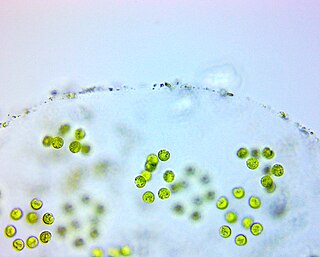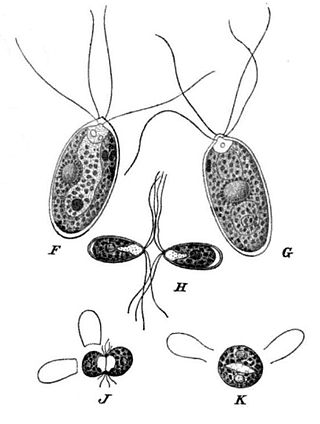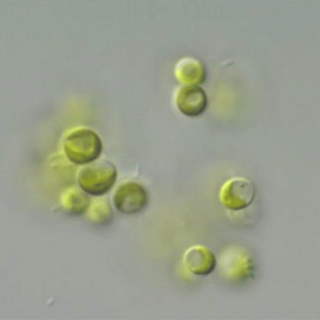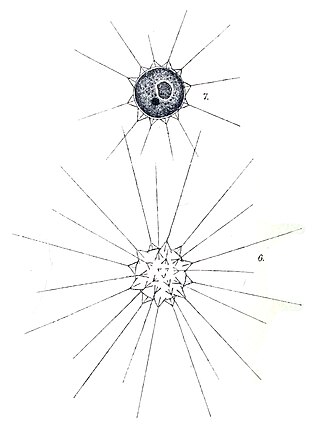
The Tetrasporaceae are a family of green algae, specifically of the Chlamydomonadales. They are found in freshwater habitats.

Ankistrodesmus is a genus of green algae in the family Selenastraceae. It is one of the most common types of phytoplankton in freshwater habitats around the world. The name Ankistrodesmus comes from the Greek roots ankistron, meaning "cross", and desmos, meaning "bond".

Asterococcus is a genus of green algae in the order Chlamydomonadales. It is planktonic in freshwater ponds and lakes, or benthic within mires and swamps. It is a common and widespread genus, but is rarely abundant.

Carteria is a genus of green algae in the family Chlamydomonadaceae. Carteria are similar in morphology to the common genus Chlamydomonas and differ by having four, rather than two, flagella at the vegetative stage.

Chlamydocapsa is a genus of green algae, specifically of the Chlorophyceae.

Dictyosphaerium is a genus of green algae, in the family Chlorellaceae. It occurs in freshwater habitats around the world and is planktonic. The name comes from the Greek roots diktyon, meaning "net", and sphaira, meaning "ball", referring to its morphology.

Hariotina is a genus of green algae in the family Scenedesmaceae. They are classified in the subfamily Coelastroideae.

Kirchneriella is a genus of green algae in the family Selenastraceae. It is found in freshwater habitats, as phytoplankton or metaphyton.

Lagerheimia is a genus of green algae in the family Oocystaceae. It is commonly found in freshwater habitats all over the world, although some species are rare and have only been recorded from Europe or the United States.

Mychonastes is a genus of green algae, specifically of the Chlorophyceae. It is the sole genus of the family Mychonastaceae.
Palmellopsis is a genus of green algae, specifically of the Palmellopsidaceae. They are either planktonic or attached to substrates in fresh water, or in aeroterrestrial habitats.
Pectodictyon is a genus of green algae in the family Sphaerodictyaceae. It is found free-floating in freshwater habitats as plankton.

Radiofilum is a genus of green algae in the class Chlorophyceae. It is a freshwater genus; they are often found in soft, boggy or acidic waters.
Raphidocelis is a genus of green algae in the family Selenastraceae. They are found in freshwater habitats.

Schroederia is a genus of green algae in the family Schroederiaceae. Schroederiaceae is a monotypic taxon; Schroederia is its only genus.

Treubaria is a genus of microscopic green algae, the sole genus in the family Treubariaceae. Treubaria is found in freshwater habitats and has a cosmopolitan distribution.

Echinosphaeridium is a genus of green algae, in the family Neochloridaceae. It is found in freshwater habitats, but it is very rare. It has only been recorded a few times since its original discovery in Sweden.
Pseudokirchneriella is a genus of green algae in the family Selenastraceae. It is found as phytoplankton in freshwater ponds, lakes, and pools. It has been reported from Europe and North America.

Aphanothece is a polyphyletic genus with 63 accepted species. The name is derived from the Greek words, ‘aphanes’ and ‘theke’ which mean “invisible" and “box or sheath” respectively. This genera is cosmopolitan, found in soils, thermal springs and other benthic, freshwater, marine, hypersaline, and moist terrestrial environments. Morphology can vary, with both microscopic and macroscopic colonies large enough to be collected and preserved in herbarium records.

Apiocystis is a genus of algae belonging to the family Tetrasporaceae. It is found attached to freshwater aquatic algae or plants. The species of this genus are found in Europe and Northern America, and are widespread but generally uncommon.
















